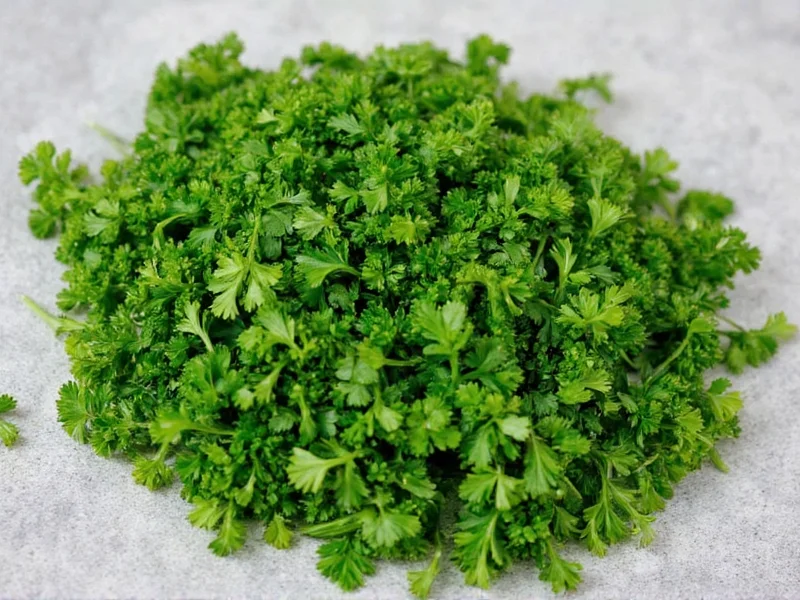Understanding fresh to dry parsley conversion is essential for home cooks and professional chefs alike. When substituting dried parsley for fresh in recipes, you need to adjust measurements properly to avoid under-seasoning or overpowering your dishes. The 3:1 ratio (fresh to dried) exists because fresh parsley contains approximately 85-90% water, while dried parsley has most of this moisture removed, concentrating the herb's essential oils and flavor compounds.
Why the 3:1 Conversion Ratio Makes Sense
The science behind fresh to dry parsley conversion lies in water content and flavor concentration. Fresh parsley's high water content dilutes its flavor, while the drying process removes moisture and intensifies the herb's natural compounds. When you use dried parsley, you're working with a more potent form of the herb that requires less quantity to achieve similar flavor impact.
It's important to note that while the 3:1 ratio is standard, some culinary experts recommend a slightly more conservative approach of 2.5:1 for delicate dishes where herb flavor should be subtle. This adjustment accounts for variations in drying methods, parsley varieties, and personal taste preferences.
Fresh to Dry Parsley Conversion Chart
| Fresh Parsley | Dried Parsley |
|---|---|
| 1 teaspoon | ⅓ teaspoon |
| 1 tablespoon | 1 teaspoon |
| ¼ cup | 1¼ tablespoons |
| ½ cup | 2½ tablespoons |
| 1 cup | ⅓ cup |
When to Use Fresh vs. Dried Parsley
Understanding fresh and dried parsley measurement conversion is only part of the equation. Knowing when to use each form elevates your cooking:
- Fresh parsley works best in dishes with short cooking times or as a finishing garnish. Its bright flavor and color enhance soups, salads, and sauces added at the end of cooking.
- Dried parsley shines in long-simmered dishes like stews, braises, and tomato sauces where it has time to rehydrate and distribute its flavor throughout the dish.
For the best results with dried parsley, consider blooming it by adding to hot oil or liquid early in the cooking process. This technique helps release its essential oils and creates a more rounded flavor profile compared to sprinkling it directly into cold ingredients.
Common Fresh to Dry Herb Conversion Mistakes
Many home cooks make these errors when converting fresh parsley to dried:
- Using equal measurements - This results in dishes that lack herb flavor since dried parsley is more concentrated
- Adding dried parsley too late - Without sufficient cooking time to rehydrate, dried herbs can taste dusty and unpleasant
- Not adjusting for recipe type - Using the same conversion ratio for all dishes without considering cooking time and method
- Storing dried herbs too long - Dried parsley loses potency after 6-12 months, requiring slightly more than the standard conversion ratio
Maximizing Flavor in Your Conversions
For optimal results when substituting dried parsley for fresh:
- Always measure dried herbs with precision - a proper tablespoon measurement makes a significant difference
- For long-cooking dishes, add dried parsley early to allow proper rehydration
- For quick-cooking dishes, consider blooming dried parsley in a small amount of warm broth or oil before adding
- When in doubt, start with slightly less than the conversion ratio suggests and adjust to taste
- Remember that dried parsley has a more earthy flavor profile compared to fresh's bright grassiness
Storage Tips for Maximum Potency
Proper storage affects your fresh to dry parsley conversion accuracy:
- Fresh parsley - Store upright in a glass with water (like flowers), covered with a plastic bag in the refrigerator. Use within 1-2 weeks for best flavor.
- Dried parsley - Keep in an airtight container away from light and heat. Properly stored, it maintains potency for 6-12 months. Older dried parsley may require slightly more than the standard conversion ratio.
Other Herb Conversion Considerations
While the 3:1 ratio works for most leafy herbs like parsley, cilantro, and basil, remember that:
- Woody herbs like rosemary and thyme follow a 4:1 fresh to dried ratio
- Garlic and onion conversions differ significantly (3 cloves fresh garlic ≈ 1 teaspoon garlic powder)
- Some herbs like chives don't dry well and are best used fresh
Frequently Asked Questions
Can I use dried parsley instead of fresh in tabbouleh?
Tabbouleh traditionally requires fresh parsley for its bright flavor and texture. Dried parsley won't provide the same fresh taste or mouthfeel. If you must substitute, use 1 teaspoon dried parsley for every 3 tablespoons fresh, but recognize the dish won't have authentic flavor.
Why does my dried parsley taste bitter when I use the standard conversion?
Bitterness often occurs when dried parsley is added too late in the cooking process. For best results, add dried parsley early to allow proper rehydration, or bloom it in warm liquid before incorporating. Older dried parsley that has lost potency may also develop bitter notes when you use more to compensate for diminished flavor.
Does the fresh to dry parsley conversion work for all parsley varieties?
The standard 3:1 conversion applies to both flat-leaf (Italian) and curly parsley. However, flat-leaf parsley generally has a more robust flavor, so some chefs use a slightly more conservative 2.5:1 ratio with this variety to prevent overpowering dishes.
How do I convert when a recipe calls for a parsley sprig?
A standard parsley sprig contains approximately 1-2 tablespoons of leaves. For dried parsley substitution, use 1/3 to 2/3 teaspoon. For recipes where the sprig is meant to be removed after cooking (like in a bouquet garni), dried parsley works well as it doesn't require removal.
Can I make my own dried parsley from fresh?
Yes, you can dry fresh parsley by hanging bunches upside down in a warm, dry, dark place for 1-2 weeks, or using a food dehydrator. When making your own dried parsley, use a 4:1 ratio initially (4 parts fresh to 1 part dried), then adjust to taste in recipes since homemade dried herbs often retain more flavor than commercial products.











 浙公网安备
33010002000092号
浙公网安备
33010002000092号 浙B2-20120091-4
浙B2-20120091-4